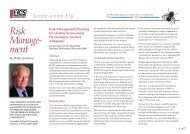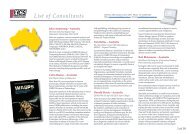Manual for Diagnosis of Screw-worm Fly - xcs consulting
Manual for Diagnosis of Screw-worm Fly - xcs consulting
Manual for Diagnosis of Screw-worm Fly - xcs consulting
You also want an ePaper? Increase the reach of your titles
YUMPU automatically turns print PDFs into web optimized ePapers that Google loves.
8.3 Sentinels (Fig. 35, Plate 8)<br />
Agriculture, Fisheries and Forestry - Australia<br />
A wounded sentinel steer will attract about 4-5 times more SWF than a s<strong>worm</strong>lure trap.<br />
Sentinel animals such as cattle and sheep are used primarily to attract gravid females<br />
which lay egg masses on the edge <strong>of</strong> the wound. The egg mass and/or resulting larvae are<br />
collected <strong>for</strong> diagnosis. During eradication programs employing sterile insect release, sterile<br />
and fertile egg masses indicate the relative success <strong>of</strong> the releases and sentinels are crucial<br />
<strong>for</strong> such monitoring.<br />
A three-panel pen which can be used as a crush <strong>for</strong> cattle has been used extensively by<br />
CSIRO <strong>for</strong> egg mass collections from sentinels throughout Papua New Guinea. Each panel<br />
(1.5 x 2.7m) is made <strong>for</strong>m 20mm OD galvanised steel pipe with rails and support struts at<br />
25cm intervals. One or two panels are secured to a tree or steel post and the third panel<br />
attached to <strong>for</strong>m a triangle. All attachments are by 12 gauge fencing wire. The animal is<br />
provided with water and a feed box containing lucerne chaff or hay. Fresh grass can also<br />
be provided if available.<br />
To restrain the sentinel, one panel is opened out a little to enable the second panel to be<br />
pushed inwards, with the animal facing the point <strong>of</strong> anchorage.<br />
Where smaller animals such as sheep and goats are available <strong>for</strong> use as sentinels,<br />
transportable sheep pens, as developed by the Mexican-American Commission <strong>for</strong> the<br />
Eradication <strong>of</strong> <strong>Screw</strong>-<strong>worm</strong>s, can be deployed (Fig. 35).<br />
Pens should be sited where SWF activity is most likely such as the edge <strong>of</strong> <strong>for</strong>ested areas,<br />
near sources <strong>of</strong> water, cattle and sheep camps or, in more open country, by using salt blocks<br />
and molasses to attract livestock in the area.<br />
To attract SWF and stimulate oviposition by gravid females, a wound with some<br />
sero-sanguinous exudate is necessary. With a scalpel blade, a 30-50mm incision is made<br />
through the dermis and into the underlying gluteal muscle <strong>of</strong> the rump. The upper rump<br />
gives easy access <strong>for</strong> observation and removal <strong>of</strong> egg masses. Egg masses are laid around<br />
the dry edges <strong>of</strong> the wound. Egg mass removal and servicing <strong>of</strong> sentinel pens is done daily,<br />
preferably during late evening or dusk when SWF activity decreases. The sentinel is held still<br />
(using the crush action <strong>of</strong> the cattle pen) and egg masses peeled <strong>of</strong>f the host with scalpel<br />
and <strong>for</strong>ceps. Egg masses in labelled pill boxes are stored in a freezer unless required <strong>for</strong> sterility<br />
check or rearing purposes.<br />
57




